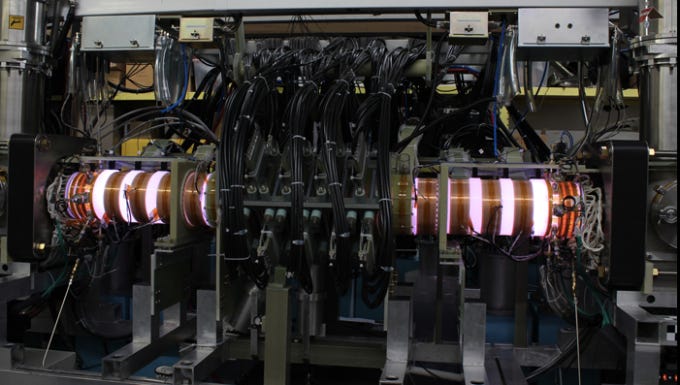My favorite startups are the ones building physical things for the physical world — but outside of Silicon Valley, few know that they exist.
Sure, everyone knows the Elon Musk oeuvre: SpaceX, Tesla, Neuralink. But Silicon Valley still equals “software” in pop culture thanks to Google, Facebook, and Amazon, and that’s a shame.
We, the Silicon Valley hardware startups, are building some truly amazing things — call us “Atoms,” in contrast to software’s “Bits.”
We are heating up plasma to 100 million degrees, resurrecting Wooly Mammoths, building quantum supercomputers, 3D-printing rockets, driving autonomous vehicles, and growing the world’s most delicious strawberries.

I believe Atoms are just as likely as Bits to build the most important technologies of the future.
And after skimming this article, I think you’ll agree.
🚗 Autonomous vehicles are already everywhere in Silicon Valley.
It’s a non-event to see a self-driving car in San Francisco — I see multiple cars from Cruise, Waymo, and Zoox every day.
Autonomous cars are still a little weird — they drive strangely, they are loaded with spinning cameras, and I’ve never seen one of them parked — but they’re absolutely coming, and coming soon.
🚁 But maybe we won’t drive at all!
The sheer range of mobility solutions being considered is stunning. Skyryse is building autonomous helicopters, Boom and Exosonic are building supersonic jets, and there are tons of flying car/taxi companies (Archer, Joby).

Most autonomous stuff is focused on consumers, but there’s also an entirely separate chunk of the market focused on commercial applications. Embark is building autonomous semi trucks, Monarch is building autonomous tractors, Hermeus is building hypersonic jets for defense applications. Two Astranis alumni are building similar companies: Boundary Layer (hyper-efficient cargo ships), and Buoyant (small blimps for air freight).
🚀 Space technology is going to change life on Earth.
Over the last decade, SpaceX has built re-usable rockets, inspiring dozens of competitors like RocketLab and ABL. Together, these companies have brought down the cost of a rocket launch by orders of magnitude, enabling new space businesses that used to be prohibitively expensive to launch.
The heavy hitters are folks like Planet (who photographs every square foot of Earth every single day), Astranis (small, dedicated communications satellites), HawkEye360 (RF imaging satellites), and OneWeb/Starlink (global satellite communications constellations).
A new generation has also recently recently emerged with Varda and Hadrian, both focused on high-precision manufacturing applications that are best accomplished in zero gravity.
⚛ Quantum computers are already more capable than their classical competitors.
In the normal world, computational power scales linearly — upgrade from 255 to 256 bits, and you’ve increased your informational capacity less than 1/2 of one percent. In the quantum world, however, computational power scales exponentially — every quantum bit (“qubit”) doubles your power.
Just 50 qubits (~2^50 bits) would be more powerful than the world’s most powerful supercomputer. And a startup, QuEra, claims to have created a 256-qubit quantum computer — the equivalent of 115,792,089,237,316,195,423,570,985,008,687,907,853,269,984,665,640,564,039,457,584,007,913,129,639,936 classical bits.

That strikes me as a little unbelievable. But other attempts are being made by Atom, Rigetti, and others — and the world’s computing capability might exponentially increase over the next decade if any one of them proves to have some secret sauce.
☢ If regulators allow it, nuclear power is coming soon.
The other startups dabbling in the subatomic world are focused on generating clean, nuclear energy. The United States Nuclear Regulatory Council unfortunately just declined Oklo’s proposal to build a compact, micro-nuclear reactor — which also may stymie the dreams of other startups like NuScale Power and TerraPower.
One ridiculously cool, orthogonally-focused player in the energy space is Helion, a startup creating the world’s first nuclear fusion reactor. After demonstrating its ability to heat a fusion plasma to 100 million degrees Celsius, the company raised $2.2 billion and is scaling up fast.
🖨 The revolution of 3D printing has extended beyond weird little plastic parts.
If you’ve ever used a 3D printer, you simultaneously understand its hype and limitations: the ability to turn a computer file into a physical object is magical, but those objects were mostly made of weird plastic — until two startups had something to say about it.
Desktop Metal is building general purpose metal and carbon-fiber 3D printers, and Relativity Space is building a massive rocket-printer. I haven’t yet seen it in person, but I hope to do so soon. (Tim, if you’re reading: hit me up!)
🧬 We’re all going to live forever.
I am no health guru, but knowing so little helps me retain a sense of childlike joy for the space’s coolest ideas.
Faeth has built a nutritional program that can starve out (and cure?) cancer. Levels is building glucose trackers that help regulate sleep, appetite, weight, and energy. And Dorian is trying to literally block aging.
Perhaps my favorite company of this category, however, is Colossal — a startup trying to resurrect the Wooly Mammoth and combat extinction.

♾ …and more!
I’ll stop here, but I could certainly keep going. There are so many more companies that I didn’t list! There’s Upside Foods (meatless meat), Anduril (next-gen defense tech), Cover (pre-fab homes), Solugen (zero-waste chemicals), Saildrone (autonomous data collection ships)… the list goes on forever.
If you want to follow the progress of the Atoms, I’d recommend that you follow the best hard-tech-specialist investors in Silicon Valley: Fifty Years, Lux, Cantos, Refactor, and more.
Or just subscribe. I’ll certainly have much more to say about Team Atoms in the near future.
Thanks for reading Silicon Valley Outsider! Here are a few past editions that you might like if you enjoyed this one:
If you want to join 600+ folks in getting an email from me each Monday, I’ll help you understand Silicon Valley using normal-human words.





